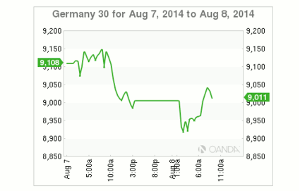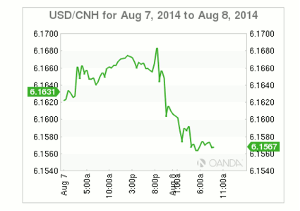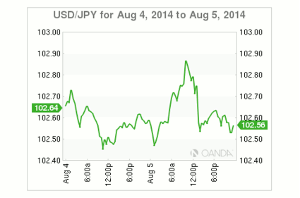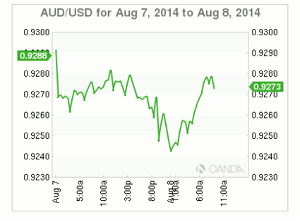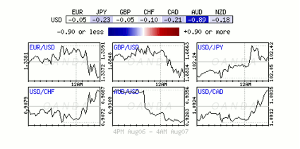Dean Popplewell of MarketPulse thinks short covering and panicky stop losses are dominating trading with relatively little real money flows going through the various asset classes, so he reviews the charts to determine how badly the forex is on edge.
Forex is beginning to buckle, commodities are bending, while equities are under pressure as investors and dealers flock to safe haven assets in an effort to rebalance their portfolios over global tensions and questionable growth. Only days ago, the International Monetary Fund (IMF) commented that capital markets have been underpricing geopolitical ramifications and that the macroeconomic repercussions have yet to be felt. Is the market finally beginning to heed that warning?
To date, safety trades have been the order of play as Russia steps up the tit-for-tat sanction war with the European Union and the US. Meanwhile, in the Middle East, war drums beat as the ceasefire between Israel and Hamas ended and President Barack Obama has authorized potential airstrikes against ISIS in Iraq. Obama's orders would only be capable of driving markets for a short period. Nevertheless, the combination of all the various geopolitical risks, poor market headlines (including Argentina’s default, the Banco Espirito Santo mess in Portugal, governance issues at various emerging market banks, and the World Health Organization declaring ebola a global risk), and historically thin liquidity in August is making the outlook rather uncertain with investors remain very nervous and trigger happy.
The market has been seeking an uptick in intraday volatility and it has arrived. Dealers are not worried in what direction market prices go. All they want is price movement; it equates to opportunity and something in short supply ever since the major central banks handcuffed the forex market with its low interest rate policy business model. Traders flourish in this environment and will do their utmost to make "hay while the sun shines."
Short covering and panicky stop losses are dominating trading with relatively little real money flows going through the various asset classes. In forex, it's no surprise to see JPY and CHF garner a safety bid with fresh five-month lows for (EUR/CHF) and eight month lows for (EUR/JPY). In stocks, equities have slumped with the Dow Jones Industrial Average and S&P 500 (SPX) shredding -0.5% on Thursday. Japan’s Nikkei closed down -3% early Friday morning, while European bourses started in the red in Friday's session. On yields, the German 10-year bund has sunk to fresh new low yield (+1.02%), while US 10-year treasury bonds are trading south of +2.4% for the first time in nearly two months. As for commodities, gold is knocking on its recent highs ($1,317) while crude oil remains a better bid on supply concerns over American airstrikes in Iraq.C2
NEXT PAGE: BoJ Last to Show its Hand|pagebreak|
The Yen Strengthens Despite BoJ
Now, add a few fundamental release events overnight on Thursday and you have a market on the edge. The Shanghai Composite is the only regional index with mild declines thus far, erasing post Obama-conference losses on much stronger than expected China trade data. A $47B surplus for July is a record high, and even though imports surprisingly fell -1.6%, a double digit rise in exports more than made up for that decline. Shipments to Europe were particularly strong, up about +17% year-over-year, while exports to Japan reversed last month's drop with a +3% increase. The danger is that the trend may not last long. With Europe under economic pressure, how can China sustain double digit export headlines? Mind you, having Russia out of the picture will certainly help their cause. The poor import reading was driven mostly by lower iron ore prices. No matter what, the pressure on the yuan to strengthen will only increase. Align that with Beijing's new measures to promote private capital outflows and that should be capable of increasing the volatility of the yuan's exchange rate.
The Bank of Japan (BoJ) was the last of the central banks to show its hand last week. Governor Haruhiko Kuroda's accompanying statement saw the BoJ maintain its overall economic assessment, unchanged for the 12th consecutive meeting. Nonetheless, as rumored, the bank has downgraded its view on exports and industrial output. In his press conference, Kuroda said he remains optimistic about Japan's economic outlook, noting the employment and income situation is improving steadily. He will be disappointed by the yen strengthening, as they see no reason to do so—(USD/JPY) is grinding lower because of risk trades unwinding and not on Japanese fundamentals.
Aussie Falls on Poor Jobs Data
Of the major currency pairs, the Aussie dollar (AUD/USD) was the biggest loser, driven by risk-off sentiment on the deteriorating situation in Iraq as well as the Reserve Bank of Australia’s (RBA) quarterly policy statement.
The RBA has cut its 2014 and 2015 gross domestic product targets by -0.25pts to +2.5% and +2.75% respectively and also narrowed lower its 2016 growth projection. On inflation, the RBA has lowered its 2014 core consumer-price index target to +2.25% versus 2.5% prior, but has risen next years to +2.75%. Following the release of 12-year high unemployment rate from Australia earlier last week, the RBA said the jobless rate is likely to remain elevated for some time yet and might not decline substantially for another 18 months. The Aussie was trading heavy all last week and managed to print a new two-month low outright ($0.9240), while continuing to struggle badly on the crosses (AUD/JPY).
The current market noise across all asset classes is not seeing relative new money being deployed, it’s only been repositioned. When it comes to de-risking, global equities have been leading the charge. Thus far, it remains an orderly trimming of riskier positions and not a rabid lemming-dash to the exit doors. Nevertheless, the lack of market liquidity could very much speed up the whole process.
By Dean Popplewell, Director of Currency Analysis and Research, MarketPulse

